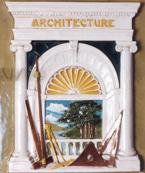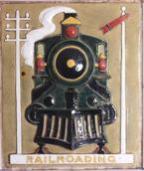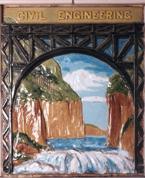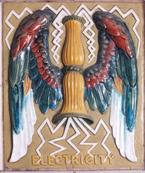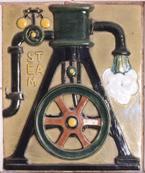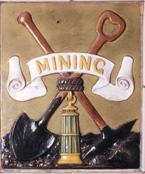1900
Electrical Engineering sponsors lectures by the Bell Co. in the new technology of telephony. The Department acquires a high-voltage laboratory, a reflection of an era when hydro-electric power was being developed and transmitted at high voltage over considerable distances.
1902
Thanks in part to financial and technological support from the Grand Trunk Railway as well as support from the Federal Minister of Railways, the Department of Railway Engineering is founded.
1903
Although aged only 28, Percy Nobbs is named the second Director of the School of Architecture. Three years later, he would design the McGill Coat of Arms that remains in use to this day.
1907
On April 5, the Macdonald Engineering Building burns. Everything in it, except the contents of the ground floor laboratories, is destroyed. Fortunately, the fire doors that were built in the adjoining Workman Technical Shops (commonly referred to as the Workman Wing) do their job, keeping the building intact and sparing it from significant damage.
Less than a week earlier the old Medical Building had burned down. Some of the stone salvaged from this fire was used to add a fourth floor to the Workman shops. The Faculty’s great sponsor, Sir William Macdonald, again stepped forward, this time volunteering to contribute to build a new structure on the foundation of its predecessor.
Percy Nobbs is asked to design and build the new structure. The University and Macdonald both stress to him the importance of function and fire resistance.
1908
Frank Dawson Adams is named Chair of Civil Engineering and Dean of the Faculty.
11 students constitute the first graduating class from Railway Engineering. Each student is required to apprentice with one of the sponsoring railway companies and accept employment with the company after graduation.
The Faculty continues to expand. The two new additions, Chemical and Metallurgical Engineering, create a roster of: Architecture, Chemistry, Chemical Engineering, Electrical Engineering, Mechanical Engineering, Metallurgical Engineering, Metallurgy, Mining and Railways.
1909
The grand opening of the rebuilt Macdonald Engineering Building is held. Although there is little ornamentation on the final structure, the carving of the phoenix rising from the flames on the south wall is a striking reminder of the fate of the original Macdonald Engineering Building, as well as its rebirth.
The rifle-shooting courses at McGill that, since 1907, had qualified students for commissions in the Canadian militia or British army, are counted as credit towards the BSc.
1910
A separate Metallurgical Engineering degree is established.
1912
The Canadian Officers’ Training Corps is established, the first at a Canadian university. This training facilitated the subsequent formation of the McGill Provisional Battalion, which served in the First World War.
The Birks Family endows a Chair in Physical Metallurgy.
Andrew McNaughton (BSc 1910) graduates with an MSc with honours in Physics and Electrical Engineering.
1913
Hired as the Macdonald Chair and Director of Architecture, Ramsay Traquair promises to regard teaching as his life’s work and design only enough to keep current. True to his word, his work in Canada is hard to find, although one creation is among the most enduring and best known of all; Traquair is credited with designing McGill’s flag.
1914
The First World War begins. At its end in 1918, 363 students or graduates of McGill will have lost their lives. A plaque in the entrance hall of the Macdonald Engineering Building commemorates most of the estimated 250 Engineering students who died.
Robert E. Jamieson, a future Dean of the Faculty, graduates from Civil Engineering and serves during the war with the Canadian artillery.
1916
One of only two students enrolled in Architecture when Percy Nobbs first arrived at McGill, successful graduate Gordon Home Blackader succumbs in London to wounds sustained while commanding a company of the 42nd Battalion of the Royal Highlanders of Canada near Ypres. The following year, in 1917, the Blackader Library of Architecture is founded in his memory with an endowment provided by his parents.
1917
As a result of the war, major railways run short on funds. This hastens the demise of Railway Engineering. The only program of its kind in Canada, it ends having graduated 44 students.
1918
Frank Dawson Adams becomes Vice-Principal and joins Henry Marshall Tory (formerly a Physics professor at McGill, and the person largely responsible for the University’s first western campus in Vancouver) in establishing the Khaki University. This was a series of credit courses, transferable to Canadian university programs, for troops returning from the war. The program encouraged veterans to continue the pursuit of higher education.
1921
The courses offered through the Faculty of Applied Science are rearranged into divisions: School of Architecture, Chemical Engineering, Civil Engineering and Surveying, Electrical Engineering, Mechanical Engineering, Metallurgical Engineering and Mining Engineering. The teaching of Practical Chemistry is discontinued.
1925
The Faculty conducts an early fundraising campaign for the construction of a new building. The campaign is successful, and a new threestorey Electrical Wing is raised on the site where the forge and foundry once stood – the foundation attached to the east end of the Workman Wing of the Engineering Building.
1926
Electrical Engineering introduces a new curriculum that includes courses in telephone system hardware and exchange operations. Behind these changes is Bell Telephone, which, at this time, employs nearly half of the Department's annual graduating class.
1927
Canada’s Department of National Defence also nudges the Department of Electrical Engineering to include training that benefits its needs. Accordingly, the Department adds a course in vacuum tube theory and wireless communication.
1928
The name of Civil Engineering and Surveying is changed to Civil Engineering.
1929
After obtaining a PhD at University College London, alumnus Fred S. Howes (BSc Electrical 1924, MSc 1926) returns to McGill as a professor and initiates training and research in electronics and radio communications. Howes is also a pioneer in offering evening engineering graduate courses to professionals.
1930
J.B. Philips completes a PhD under Harold Hibbert of the Chemistry Department and is offered a teaching job in Chemical Engineering, with the stipulation that he will spend a year at MIT to prepare to teach the subject. Philips returns in 1931 and revamps the program using the MIT courses as a guide, thus making McGill the Canadian leader in these studies.
1931
The Faculty of Applied Science becomes the Faculty of Engineering. It offers two degrees – Bachelor of Engineering (BEng) and Master of Engineering (MEng).
McGill introduces a completely revised curriculum in Chemical Engineering, to be administered by the Department of Chemistry.
1933
Robert Shaw (DSc 1985), later the Deputy Commissioner-General for Expo '67, graduates from McGill with a degree in Civil Engineering.
1935
Chemical Engineering awards its first PhD to R.D. Bennett (BEng Chemical 1932, MSc 1933).
1938
McGill approves the admission of women to the BArch program. None was admitted because women’s restroom facilities remained to be added. Dean of Engineering Ernest Brown requests capital expenditure funds of $1,400 to provide these facilities.
1939
World War Two begins.
1941
Philip Turner, who succeeded Traquair as Director of the School of Architecture, fights hard against those seeking to shut down the school as a result of a temporary drop in enrolment. Having enlisted the support of several distinguished Montreal architects, Turner and his Executive Secretary (and eventual successor) John Bland (BArch 1933) join with newly appointed principal F. Cyril James in arguing that in the post-war reconstruction period, architects would be needed more than ever before. Avoiding extinction, the School then scores two key hiring coups – Group of Seven founding member Arthur Lismer, and Gordon Webber, an artist and exceptional teacher who had studied with László Moholy-Nagy at the New Bauhaus in Chicago.
Bland expands the scope of the School to prepare for post-war rebuilding by adding training in housing design and urban planning. Recognizing the importance of maintaining the union of Architecture and Engineering, Bland insists that his students take engineering courses even if it is "painful for the man with a flair for design to suffer the minutiae of structural calculations."
For the fall term, 106 students enrol in one of five courses offered in Electrical Engineering's new fourth-year Communications Option. The option was introduced to satisfy industry demand for wartime radio engineers.
1943
Catherine Chard (later Catherine Chard Wisnicki) becomes the first woman to graduate (with distinction) from the School of Architecture. Following a move to Vancouver in 1946, she became an inspiring teacher at the University of British Columbia and a pioneer of the West Coast style. At the Engineering convocation in 1996, the faculty awarded her an honorary Doctor of Science degree.
1945
To accommodate the influx of returning veterans, McGill negotiates with the Royal Canadian Air Force for the use of its base at St. John’s, Quebec (now Saint-Jean-sur- Richelieu). Located some 30 km from Montreal, the base is renamed Sir William Dawson College and is populated mainly by engineering and science students, who are required to live on the site. Dawson College opens for teaching on October 1 with 620 students on site.
1946
Mary Blair Jackson (later Mary Fowler) graduates from Mechanical Engineering, McGill’s first woman Engineering (non-Architecture) graduate. She would go on to become a pilot officer at RCAF training command headquarters in Trenton, Ontario, where she conducted statistical work connected with the training of ground crews.
Chemical Engineering becomes a separate department in the Faculty. J.B. Philips serves as the newly recognized Department’s first Chair.
Electrical Engineering obtains war surplus equipment (much of it donated by the War Assets Commission) for its Power and Communication laboratories.
School of Architecture Director John Bland and Harold Spence-Sales establish Canada’s first postgraduate architectural and planning program. The Planning Program was interdisciplinary, with a Master’s degree being granted in the students' undergraduate disciplines. Before being transformed into the School of Urban Planning in 1976, this program graduated 83 planners, many of whom subsequently assumed key positions in Canada's planning profession.
1947
A fifth floor is added to the Workman Wing, and a new entrance built. Existing labs become offices and classrooms.
Future Dean Donald Mordell joins Mechanical Engineering. Mordell’s revitalizing and optimistic influence was as welcome as were his innovative research contributions, particularly with the controversial Gerald Bull on the High Altitude Research Project (HARP). Beginning in 1961, with material support from the United States Army, this McGill research team began developing and testing a 16-inch gun system capable of firing ballistic projectiles and missiles to high altitudes.
The program was terminated in the mid-1960s before the ultimate goal of launching an orbital vehicle was achieved.
1948
The Department of Mechanical Engineering awards its first PhDs.
1949
The Faculty takes over administration of the pre-Engineering year from the Faculty of Arts and Science. The course of instruction within Engineering, following Quebec Grade 11, is thus extended from four to five years.
Construction begins on the Physical Sciences Centre, the first new building for Engineering since 1925. Renamed the Frank Dawson Adams Building in 1971 (in honour of the Faculty’s second Dean who also served as McGill Vice-Principal from 1920-24), the three-storey, unadorned structure links the Macdonald Engineering and the Macdonald Mining and Chemistry Buildings. The building’s west entrance connects to the campus via a small bridge.
1950
Dawson College closes; of the estimated 5,600 students to pass through, some 1,490 engineering and 105 architectural students studied there at some point during the college’s five-year existence.
With its worldwide reputation as among the best undergraduate programs in engineering long since established, the Faculty strives to add another dimension to its reputation, that of a pre-eminent postgraduate and research facility. Not always a popular direction with traditionalists both within and outside the Faculty who resist the idea of advanced degrees within Engineering, the end of the decade finds McGill as an emerging centre for advanced and experimental postgraduate research in many areas.
